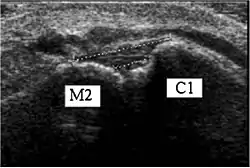Lisfranc ligament
The Lisfranc ligament is one of several ligaments which connects the medial cuneiform bone to the second metatarsal. Sometimes, the term Lisfranc ligament refers specifically to the ligament that connects the superior, lateral surface of the medial cuneiform to the superior, medial surface of the base of the second metatarsal.
| Lisfranc ligament | |
|---|---|
 Lisfranc ligaments:[1] C1 = Medial cuneiform M2 = 2nd metatarsal base M3 = 3rd metatarsal base Red = dorsal Lisfranc ligament Blue = interosseous Lisfranc ligament Green = plantar Lisfranc ligament. | |
 Ultrasonography of the dorsal Lisfranc ligament.[1] | |
| Anatomical terminology |
Structure

The Lisfranc ligament connects the medial cuneiform bone to the second metatarsal.[2] It is a complex of 3 ligaments: the dorsal Lisfranc ligament, the interosseous Lisfranc ligament, and the plantar Lisfranc ligament.[2][3]
Variation
In 20% of people, there are two bands of each component of the ligament, usually of the dorsal Lisfranc ligament or the plantar Lisfranc ligament.
Function
The Lisfranc ligament maintains proper alignment between the metatarsal bones and the tarsal bones.[3] It acts as a shock absorber during the weight bearing phase of the bipedal gait cycle.[3] It also compensates for the lack of an intermetatarsal ligament between the first metatarsal bone and the second metatarsal bone.[3]
Clinical significance
The Lisfranc ligament is injured or disrupted in the Lisfranc fracture. Trauma to the midfoot is caused by direct and indirect impact forces. Direct force involves an object landing on the surface on the foot. Indirect force involves twisting of the foot, usually an impact to the heel while the foot is pointed down toward the ground.[4] A mild form of this injury results in a widening of the gap between the first and second metatarsals. An extreme form of the a Lisfranc fracture causes a complete dislocation of the metatarsals from the tarsal bones. When the alignment of the midfoot is affected joint cartilage is quickly damaged.[5]
History
Eponym
The ligament and the fracture are named after the Napoleonic army surgeon, Jacques Lisfranc de St. Martin.[6]
References
- Rettedal, David D; Graves, Nathan C; Marshall, Joshua J; Frush, Katherine; Vardaxis, Vassilios (2013). "Reliability of ultrasound imaging in the assessment of the dorsal Lisfranc ligament". Journal of Foot and Ankle Research. 6 (1). doi:10.1186/1757-1146-6-7. ISSN 1757-1146. PMC 3626864. PMID 23453037.
- Sripanich, Yantarat; Steadman, Jesse; Krähenbühl, Nicola; Rungprai, Chamnanni; Saltzman, Charles L.; Lenz, Amy; Barg, Alexej (2021-02-02). "Anatomy and Biomechanics of Lisfranc Ligamentous Complex: A Systematic Literature Review". Journal of Biomechanics: 110287. doi:10.1016/j.jbiomech.2021.110287. ISSN 0021-9290.
- Ryba, Dalton; Ibrahim, Nooreen; Choi, Jim; Vardaxis, Vassilios (2016-03-01). "Evaluation of dorsal Lisfranc ligament deformation with load using ultrasound imaging". The Foot. 26: 30–35. doi:10.1016/j.foot.2015.10.004. ISSN 0958-2592.
- "Lisfranc Injuries".
- "Lisfranc (Midfoot) Injury-OrthoInfo - AAOS". 1 December 2011.
- synd/3056 at Who Named It?